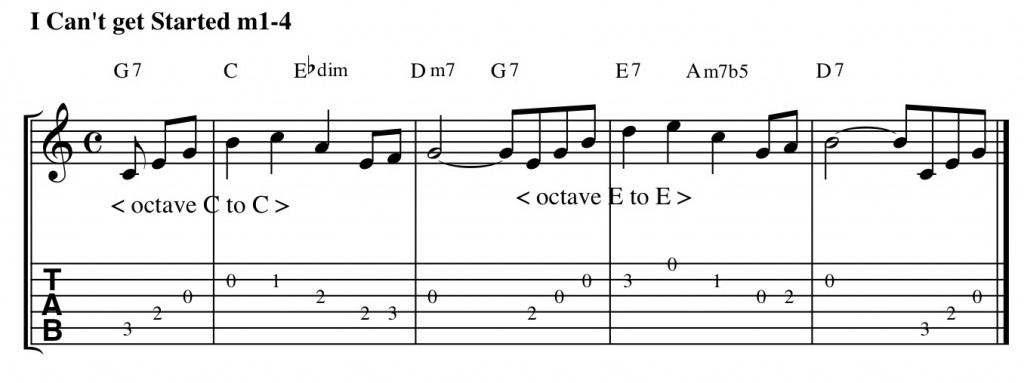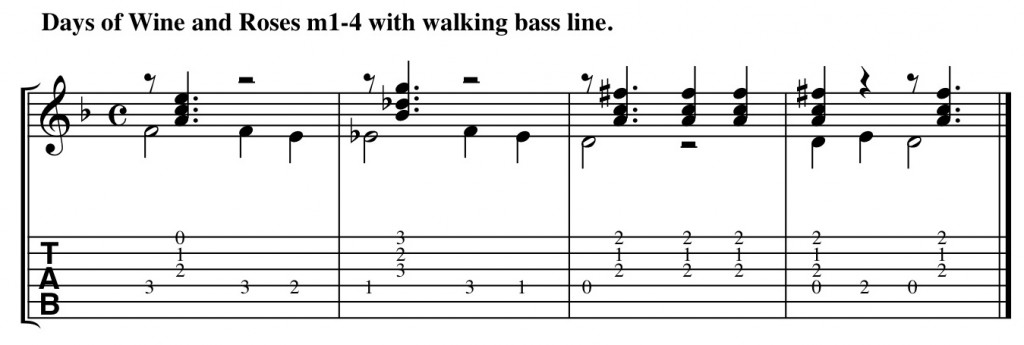Some more footage from Cafe Tibo in Glasgow. Myself, Alan Geddes, and Olivia Ennemoser performing the classsic song Duke Ellington song I’m beginning to see the Light. Click here to go to my songbook page for the song where you’ll find some background, analysis and suggested listening
Herb Ellis Jazz Guitar – The Days of Wine and Roses
A great rendition of the classic song The Days of Wine and Roses is introduced in the clip below by Jazz Guitarist Herb Ellis where he talks about his early days in Jazz. Born in 1921, Ellis started out his musical life as a double bass player. As he refers to in the video clip, due to a lack of funds he dropped from college where he was studying the double bass, going onto to play guitar in a college band. Bit of a similarity to myself here in that I originally played the Bass in the Glasgow Youth Band, a Jazz Orchestra, before switching onto guitar. After a number of bands and a gaining reputation he played in Tommy Dorseys band 1946 through to 1947. Another highlight of his career would have to be replacing Barney Kessel in the Oscar Peterson Trio. While many of the guitarists who came up in the 1940’s where influenced by Charlie Christian it’s perhaps in Herb Ellis’s playing where we can always here echoes of the lineage. Go to my Days of Wine and Roses Guitar Song Lesson for some background of the song and recommended lsitening and also my Days of Wine and Roses and adding a bass line blog for further reading.
I Can’t Get Started Guitar Melody
CLICK HERE to access EXCLUSIVE CONTENT in my ‘BEYOND TABS’ guitar course
When your writing your own melodies or playing your own improvisations you can get great ideas from looking at what the masters have done. If you start with the melodies you like, the songs that have stood the test of time, then you can’t go far wrong. In the example below I’ve started to have a look at what is going on in the first measures of the classic Vernn Duke and Ira Gershwin song I Can’t Get Started. On first listening it sounds as if it could be a bit of a vocal challenge with an octave leap in the melody in the pickup / measure 1 and also measures 2/3. In my Beyond Tabs guitar course I look at how we can analyse melodies in terms of leaps, stepwise motion and how the use of intervals can create tension and resolution in the music. In the example below there’s a certain tension created by these two octave leaps. However the tension is very cleverly tempered by the use steps which miss out every second note. To my ear this gives a symmetry to the melody which tempers the tension of the leap. This is the kind of idea that we can take and play around with when we are creating our own music. In my guitar course I also cover the area of ear training. A good way of remembering intervals, chord tones etc is to identify them in songs that you know. You’ll notice that the first 4 notes of I can’t get started form a Cmaj7 chord….try singing tyhem through. If your not familiar with the melody go to my I Can’t Get Started Guitar Song Lesson where you’ll find my recommended listening for the song.
Days of Wine and Roses and adding a bass line
When you are playing through a swing type chord progression the most common rhythm to play would be “four in the bar”. This means that you would strum the chord or if you play in a fingerpicking style, pick the the notes of the chords simultaneausly, 4 times in each measure. This is demonstrated in example 1 below where I’m showing the first 4 measures of the classic song “The Days of Wine and Roses”. This type of rhythm will create a great feel if executed properly. If you’re looking to add a bit of variety to you’re playing then you should consider adding some bass notes to your chord arrangement. In example 2 below I’ve taken the same 4 measures as in example 1, varying the rhythm and adding some bass notes. Try playing both examples. Both are valid and both are interesting for different reasons. Variety, which is something I always promote in my video guitar lessons, is the key here.
Further Reading:
Go to the Days of Wine and Roses guitar chord lesson for some song background and my recommended listening
Go to my Herb Ellis Jazz Guitar – The Days of Wine and Roses blog where you’ll find a great rendition along with a short biography for this great guitarist.
Example 1
Example 2
What Is This Thing Called Love Guitar Lesson
CLICK HERE to access EXCLUSIVE CONTENT in my ‘BEYOND TABS’ guitar course
|
|
| Song Background | |
| The classic song What Is This Thing Called Love was written by Cole Porter in 1929 for the musical Wake Up and Dream. The song has become a very popular jazz standard. Usually performed at a fast tempo, it has been recorded by artists such as Sonny Rollins, Sidney Bechet and Billie Holiday. A number of songs have been inspired and linked to the song including John Coltrane’s fifth House inspired by Tad Dameron’s “Hot House” which drew ipiration from “What is this thing called love”. I’ve included some of my favourite renditions of the song below. | |
| Guitar Chord Progression Analysis | |
| Suggested Listening | |
|
Barney Kessel
|
Billie Holiday |
|
Sonny Rollins
|
Keith Jarrett
|
| Which artist’s version of This Thing Called Love would you recommend? Tell me about it and I can feature it here | |
I Can’t Get Started Guitar Song Lesson
CLICK HERE to access EXCLUSIVE CONTENT in my ‘BEYOND TABS’ guitar course
|
|
| Song Background | |
| The music for the popular song I Can’t Get Started was written by Vernon Duke with lyrics by Ira Gershwin. It was first heard in 1936 on the theatre production of Ziegfield Follies where it was sung by Bob Hope. After it’s initial success it came back to public attention in 1937 when Bunny Berigan, a virtuoso trumpeter who originally played with Benny goodman and Tommy Dorsey, started his own band and made it his theme tune. It has been recorded by many artists over the years including Billie Holiday, Nat King Cole and Frank Sanatra. I’ve listed some of my favourite recordings below. | |
| Guitar Chord Progression Analysis | |
| Check out my blog on the I Can’t get started melody where I take a look at what is happening in the first 4 measures of the tune | |
| Suggested Listening | |
| Bunny Berigan
|
Joe Pass
|
|
Jamie Cullum
|
Lester Young
|
|
|
Which artist’s version of I Can’t Get Started would you recommend? Tell me about it and I can feature it here |
Corcovado
Recent footage from our Cafe Tibo gig in Glasgow…Geddes-Ennemoser Duo performing Corcovado
Round Midnight – Thelonious Monk Live
CLICK HERE to access EXCLUSIVE CONTENT in my ‘BEYOND TABS’ guitar course
How cool is this performance. I referred to angular melodic shapes in my previous blog on the Round Midnight guitar melody. Listen to how Monk Accents the angles in his introduction.
‘Round Midnight Guitar Melody
CLICK HERE to access EXCLUSIVE CONTENT in my ‘BEYOND TABS’ guitar course
Take a look at the angular shape of the melody of ‘Round Midnight. In my guitar course I cover the topic of intervals and melodic motion in more detail. As an introduction to the concepts, angular shapes like the ones below create a sense of agitation, tension in the music while stepwise motion will tend to create a feeling of calm and resolution. If your interested in reading more about my thought on melody, come and join the my Beyond Tabs guitar course. For some more background on the song and further analysis go to my ‘Round Midnight Guitar Song lesson
‘Round Midnight Guitar Song Lesson
CLICK HERE to access EXCLUSIVE CONTENT in my ‘BEYOND TABS’ guitar course |
|
| Song Background | |
| ‘Round Midnight is a jazz standard written in 1936 by jazz piano player Thelonious Monk. It was first recorded by Cootie Williams and his orhestra in 1944 and it went on to become their theme song. While being heralded as one of the most recorded jazz standards of all time, a pivotal recording was that of Miles Davis at the 1955 Newport Jazz festival. That band included many great names including John Coltrane (tenor saxaphone), Red Garland (piano), Paul Chambers (bass), and Philly Joe Jones (drums). I fell in love with the song after watching the film of the same name which starred Dexter Gordon whose character Dale Turner was loosely based on the lives of Bud Powell and Lester Young. I’ve listed some of my favourite recordings of the song below. Go to my blog on Round Midnight Thelonious Monk Live to watch a a live performance. | |
| Guitar Chord Progression Analysis | |
| While being one of the most recorded Jazz tunes of all time, there would seem to be a bit of debate about the chord progression for ‘Round Midnight. The chord changes for the song are laid out in the Real Book, the bible for Jazz musicisians. The progressions starts off with a minor turnaround and then goes through a number of 11-V changes. However, when you listen to Monk playing the song the changes are not so straightfoward. This is a good lesson in using your ears and listening. Check out my blog on the Round Midnight Guitar Melody where I have a look at the melodies angular shape. | |
| Suggested Listening | |
| Thelonious Monk
I think it’s good to listen to versions of songs by the composers themselves as it gives you an insight into where they were originally coming from. Be informed by other versions that inspire you but it’s good to be aware of the original |
Miles Davis
Great moody playing on this recording with Miles Davis at his best |
|
Joe Pass Once again virtuoso playing from Joe pass. Great moving lines and re-harmonisation played in a fingerpicking style. If you would like some guitar lessons to help you play like Joe check out my FREE Beyond Tabs guitar course where you’ll find over 2 hours of video guitar lessons |
Jackie Paris Jackie Paris was great singer from the bepop era. Great rendition of this classic song. |
|
Andy Summers This version was suggested by Joe. I love the huskiness of Sting’s voice with the solo guitar before the other instruments gradually come in. Great contemporary feel that absolutely works with this classic standard. Great suggestion Joe |
Which artist’s version of ‘Round Midnight would you recommend? Tell me about it and I can feature it here |



